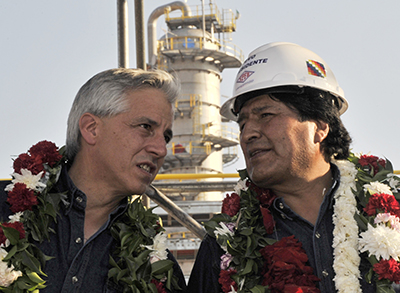Álvaro García Linera’s savvy use of the media helped him make the leap from Marxist guerrilla to vice president of Bolivia. But critics contend that as the country’s second-highest elected official, García Linera is now using his substantial power to manipulate and control the Bolivian news media.
Journalists told CPJ that García Linera, who was a prominent talking head on TV news programs in the early 2000s, is a driving force behind the administration’s controversial media policies. These include depriving critical news outlets of government advertising and turning state-run and taxpayer-financed Bolivia TV into a mouth piece for Morales, reporters and media analysts told the Committee to Protect Journalists.
“García Linera controls the government’s media agenda and defines its strategy,” Andrés Gómez, the director of Bolivia’s independent ERBOL radio network, told CPJ.
In his best-selling book Control Remoto (Remote Control), Bolivian journalist Raúl Peñaranda portrayed García Linera as a key figure in a government campaign to gain the editorial support of several major media outlets through their purchase by business people allied with left-wing President Evo Morales.
In the wake of these efforts, Morales has boasted in the press that the majority of the Bolivian news media now support his government. Amid this mostly positive news coverage, the Morales-García Linera ticket won a third consecutive term in the October 12 election with 61 percent of the vote.
García Linera, 52, did not respond to CPJ’s requests for comment. But at a March news conference he brushed off the notion that he has some special hold over the news media.
“They say the vice president controls the media. My god! I have more important things to do,” García Linera told reporters.
Back in the 1990s, the Bolivian media branded García Linera as a terrorist. Along with his brother, Raúl, he was one of the founding members of the Tupac Katari Guerrilla Army, a pro-indigenous Marxist rebel group that carried out robberies and bombings of pipelines and energy pylons.
“García Linera wasn’t struggling against a dictatorship. He was fighting against a democracy,” Rafael Loayza, who heads the communications department at the Bolivian Catholic University in La Paz, told CPJ.
In April 1992, 12 members of the rebel group were captured including García Linera, who claims to have been tortured while in police custody. He spent the next five years in prison but was never brought to trial, and was released in 1997.
Once out of prison, the photogenic García Linera carved out a new career as a university professor and news commentator on TV programs including El Pentágono. Peñaranda described García Linera to CPJ as extremely effective on TV, especially in the early 2000s when Bolivia’s U.S.-backed center-right governments faced growing protests from Bolivia’s Aymara and Quechua Indians who make up the majority of the population and had long felt excluded and ignored.
“It was a moment of transition from the old regime to the new,” Peñaranda told CPJ. “The old TV analysts couldn’t explain it. They were good for analyzing stability, but not conflict. García Linera is very intelligent and articulate, and he was able to explain things very well.”
Rafael Archondo, a columnist for the largest daily in La Paz, La Razón, told CPJ that García Linera “became famous not because he was a guerrilla fighter but because he was on TV.”
In 2005, García Linera parlayed this prominence into an alliance with Evo Morales, an Aymara Indian and rising political star. The Morales-García Linera ticket won that year’s presidential election by a landslide, making Morales Bolivia’s first president of indigenous origin.
His government faced an extremely critical news media during its first term. But in Remote Control, Peñaranda claims that starting in 2008 the government began a series of maneuvers to force the sale of La Razón and the television stations ATB, PAT and Full TV.
After La Razón was sold in 2008 to a Venezuelan businessman allied with the government, Peñaranda describes García Linera selecting the new editor of La Razón, whose editorial line now supports the Morales administration. La Razón editor Claudia Benavente has denied that she was named to the post by the vice president.
To gain a media footing in the city of Santa Cruz, an opposition stronghold in eastern Bolivia, according to Remote Control, the Morales government targeted the PAT television station with tax audits and corruption investigations of its then-owner Abdallah Daher. The book describes García Linera meeting with a reluctant Daher in Buenos Aires in an effort to seal the deal. Daher sold the station in 2012 and since then PAT’s news programs have provided generally positive coverage of the Morales government, Archondo said. According to news reports, all the media outlets named in his book denied Peñaranda’s claims.
The government has never acknowledged any role in the sale of PAT. But in March, Humberto Roca, one of Daher’s former business partners, called García Linera “the principle actor” in the sale of PAT.
Opposition politician Jimena Costa claims that the government’s media strategy has been imported from Venezuela. There, the late socialist leader Hugo Chávez and current President Nicolás Maduro used fines, government advertising boycotts, and the sale of independent media outlets to business allies to greatly reduce critical news coverage according to CPJ research.
“It’s a Venezuelan script that has been adapted to the circumstances in Bolivia,” Costa told CPJ.
In an interview with CPJ, Communications Minister Amanda Dávila said Peñaranda’s book was full of errors and denied that the government had undertaken a silent campaign to gain greater control over the news media.
García Linera, meanwhile, has solidified his ties to Bolivia’s news media through marriage. In 2012, he wed Claudia Fernández, a news anchor for the independent TV station Red UNO–which provided live coverage of the ceremony.
